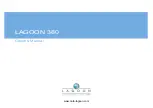
CHAPTER 5
FUEL SYSTEM
- 23 -
34z
5.0 GENERAL
It is important to understand the fuel system aboard your boat. Diesel fuel is different than
gasoline. In most respects it is safer, however precautions need to be taken to maintain the safety
of your boat. Please study the safety precautions in the NMMA publication “Sportfish, Cruisers,
Yachts – Owner’s Manual.”
Diesel engines need to intake more fuel than they burn, and so they differ from gasoline engines
in that they return excess fuel to the tank. Both feed & return of port and starboard engines are to
their respective 175-gallon fuel tanks. The two fuel tanks are connected at the bottom by a
“compensating” fuel line with isolating shut-off valves at both aft inboard corners.
5.1
FUEL SHUT-OFF VALVES
These valves are located on top of the fuel tanks aft and are accessed through pilothouse seat
lockers. In the photos below they are shown in the open position, parallel with the fuel lines.
These valves should be shut down if inspecting a Racor filter, in an emergency
or in case of a fire in the engine compartment.
5.2
FILLING THE TANKS
Deck fills are mounted on the side decks, port & starboard, and are labeled “DIESEL.” Each one
services only its respective tank, although with the connecting fuel line valve open, you will get
some transfer to the opposite tank. As the tank is filled, vapor escapes the tank thru the vent.
Overflow is prevented by an in-line fuel/air separator that will not allow fuel to pass.
should be taken while filling. Check the fuel level gauges and listen for the rise
in pitch at the deck fill, as fuel reaches the top. Shut off the nozzle immediately.
Do not attempt
to
“top off” the tanks. Have an absorbent cloth handy to prevent any overboard spillage. Variations
in temperature as well as trim angle could cause overflow or vent-line blockage.
STARBOARD TANK showing fuel shut-off
and top of fuel level sensor (right center)
PORT TANK showing fuel shut-off for port
engine and generator (center hose).
















































